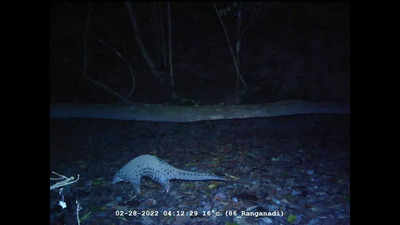- News
- City News
- guwahati News
- Raimona National Park records rare Chinese pangolin sighting
Trending
Raimona National Park records rare Chinese pangolin sighting
A team led by the Kachugaon forest division, Assam forest department, and conservationists from Aaranyak, a biodiversity conservation organisation, made this discovery. The photograph was captured on a dry stream that joins with the Ranganadi river, covered with semi-deciduous forest dominated by Sal trees. The surface around the camera station was primarily blanketed by small to medium stones covered by dry leaf litter. This is the first confirmed photographic evidence of the Chinese Pangolin in Raimona National Park (RNP).
The Chinese Pangolin (Manis pentadactyla) is a highly trafficked, elusive, solitary, nocturnal, burrowing mammal with scarce information on its distribution and current occurrence across its range.
"This interesting finding of the occurrence of the Chinese Pangolin in Raimona National Park was recorded as part of continuous research aimed at improving conservation efforts in the national park. This will, in my opinion, strengthen the spirit of conservation in Raimona and help ensure that more elusive findings will soon be recorded," said Bhanu Sinha, DFO of Raimona National Park.
"The paper also clarified confusion regarding the occurrence of the Indian Pangolin in Assam and Northeast India, which will potentially rectify the distribution map of the IUCN Red List," said the lead author of the paper, Dipankar Lahkar, a senior conservation biologist with Aaranyak.
Aaranyak's senior scientist M Firoz Ahmed, Bhanu Sinha, Pranjal Talukdar, Biswajit Basumatary, Tunu Basumatary, Ramie H Begum, Nibir Medhi, Nitul Kalita, and Abishek Harihar also contributed to the paper.
There are two species of pangolins—Indian Pangolin (Manis crassicaudata) and Chinese Pangolin—that occur in India, according to the publication.
"Considering the high extinction risks due to low population levels and extensive hunting and poaching for illegal trafficking, the Chinese Pangolin was listed in Appendix-I of CITES, as ‘Critically Endangered' in the IUCN Red List, and in Schedule-I of the Indian Wildlife (Protection) Act, 1972. In India, despite stringent legal protections, pangolins are continuously hunted for meat, body parts, and traditional medicinal purposes," the publication states.
The Chinese Pangolin is currently sighted in eastern, northern, and southeastern Asian countries, spanning India, Bhutan, Bangladesh, Nepal, Myanmar, Thailand, China, Hong Kong, Taiwan, Laos, and Vietnam at elevations of 0-3,000 m. In India, the Chinese Pangolin is restricted to the foothills of the Himalayas, in the northern and northeastern regions.
RNP is located along the foothills of the Himalayas and is contiguous with the Phibsoo Wildlife Sanctuary of Bhutan, the westernmost protected area within the India-Bhutan Transboundary Manas Conservation Area.
End of Article
FOLLOW US ON SOCIAL MEDIA
Visual Stories
Hot Picks
TOP TRENDING
Explore Every Corner
Across The Globe












